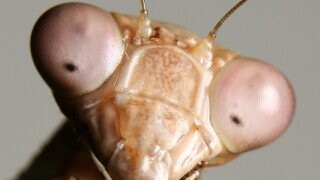Bug Eyes Hold A Weird Secret

Let's start by telling you two things that you probably already knew, but which you might never have really put together before. The first is that, sometimes, insect eyes have black dots in the middle. Check it out—that bug is looking right at you! Nice.
The second is that insects have compound eyes. Rather than one big ball with a single hole that focuses light onto a surface, so info can travel down a nerve, each insect has thousands of holes like that, each with its own lens and cornea. These holes take the form of tubes, called ommatidia. Just one of your eyes has more light-sensitive cells than, say, all 30,000 of a dragonfly's ommatidia, so you see the world much more clearly than any insect can. Compound eyes offer other advantages, however. A single tiny eye can see a wide field of view (150 degrees, which is a bit more than one of your eyes, despite being so much simpler). It's also very sensitive to motion.
So, back to those black dots then. Those aren't really pupils, because each eye doesn't have a pupil. Each of those black dots is a cluster of ommatidia. It looks black because you're staring right down the tube, a tube that light travels down and doesn't escape. The bug's eye has thousands of other tubes as well, but since you don't look straight down them, you see those tubes' inner edges. Light goes in, bounces off those edges, and comes out colored.
Don't Miss
In that way, the black bits aren't so different from pupils. Pupils too are holes that let in light. But pupils move around, pointing at whatever the person's looking at. The black bit (known as a pseudopupil) doesn't face what the bug's looking at because the bug is looking at everything. The pseudopupil is just wherever you're looking.
If you now move (around a real-life bug, not around a photo of one), so you're looking at the bug from a different angle, you'll now see different ommatidia forming the pseudopupil. The bug isn't looking at anything different, and it hasn't moved its eyes, but it seems as though it's rotated those eyeballs so it's looking your way, just because you're looking straight down different tubes. At least, that's what would happen if the bug stays totally still throughout this. More likely, the bug will use those compound eyes to sense your slightest movement and then immediately flee.
This fact came from the One Cracked Fact newsletter. Want more like this, straight from your email inbox, without any ads or popups? Join here:
For more facts that bug us, check out:
Malaria Hacks Your Body Odor to Make You Delicious to Bloodsuckers
Ants Use Mercenaries and Forge Alliances
The Fly That Snacks On Baby Birds
Follow Ryan Menezes on Twitter for more stuff no one should see.
Top image: Steve Smith
